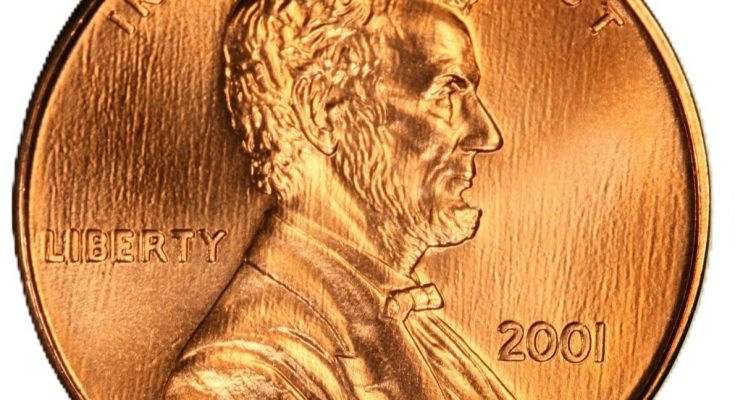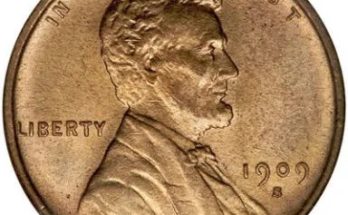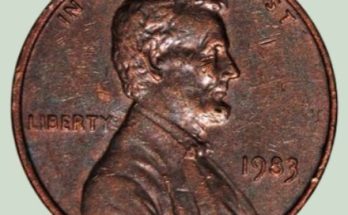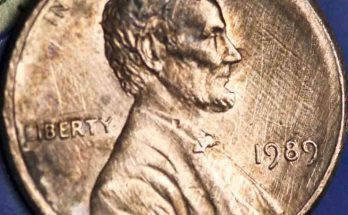Are you an Abraham Lincoln fan and love collecting pennies? Do you wonder how much is a 2001 penny worth? Are pennies worth collecting? If these questions are at the top of your mind, our 2001 penny errors list will help! You will discover high-value pennies that can drastically elevate the value of your collection whether you are a new hobbyist or experienced collector.
In 2001, the United States Mint produced approximately 10 billion Lincoln pennies at the Philadelphia and Denver mints. The San Francisco mint also produced millions of proof coins for collectors. With so many coins in circulation, 2001 pennies are only worth their face value. Even uncirculated examples are quite affordable and easily accessible from graded MS65 to MS67, although coins graded MS68 and above are scarce and worth slightly more than face value.
So, if 2001 pennies are only worth their face value are they really worth collecting? The answer is yes! If you know what to look for you can build a valuable collection—collecting errors is one of the best ways to do this.
As our list of 2001 pennies will reveal, collecting errors can be rewarding as these coins can be worth hundreds and even thousands. So, without further ado let’s jump in and discover 2001 Lincoln pennies worth money.
1. 2001-D MS65 Penny Multiple Strikes Error
When collecting 2001 pennies, you might come across one with a multiple strikes error, which could be worth a premium. As the name implies, this error occurs when a coin is struck more than once, usually due to a technical failure in the minting press.
A coin with a multiple strikes error will have two distinct strikes on the same side of the coin. For example, on some pennies you might find that Lincoln’s portrait and the lettering on the obverse overlap at an angle due to the obverse die striking the planchet more than once. On the reverse, you might also notice evidence of repeated impressions of the Memorial and inscriptions.
The value of such an error coin will usually depend on the intensity of the strike—the more intense or dramatic the multiple strikes, the more valuable the coin will tend to be. In 2015, a 2001-D penny graded MS65 with a multiple strikes error fetched $940 at a GreatCollections auction, making this a nice addition to your collection.
2. 2001-P MS66 Penny Die Crack Error
Another error that comes up in the 2001 penny series is the die crack. This error occurs when the die develops a fracture, usually due to prolonged use or stress. The cracks from the damaged die are then transferred to the planchet, creating raised lines or fissures on the coin’s surface.
These cracks start as small imperfections but grow as the die continues to strike planchets, producing more pronounced errors. Die cracks come in a variety of shapes and patterns, but the larger, more dramatic or peculiar the error, the more valuable it tends to be.
In 2017, a 2001-P Penny graded MS66 with a die crack error running from Lincoln’s shoulder to the rim sold for an impressive $875 at a Heritage Auction.
3. 2001-D MS68 Penny Off-Center Strike Error
The next one on our 2001 penny errors list is the off-center strike, which occurs when a planchet is improperly aligned in the minting press. This results in the design being struck away from the center, leaving a portion of the coin blank.
Off-center strike errors vary widely in severity, with more dramatic off-center strikes being rarer and more valuable. For example, a coin with a 40% off-center strike will usually be more valuable than one with a 10% off-center strike.
Even better, coins with visible dates and mint marks, are more desirable given that in most cases the off-center error will obscure these details.
In 2012, a collector bought a 2001-D penny graded MS68 with an off-center strike error for a whopping $1,150 in a competitive eBay auction, demonstrating the appeal of off-center strike errors. This particular coin had an impressive 15% off-center strike, with a portion of Lincoln’s portrait shifting toward the edge and leaving a blank area that makes the coin visually appealing.
4. 2001-S MS66 Penny Double Die Obverse Error
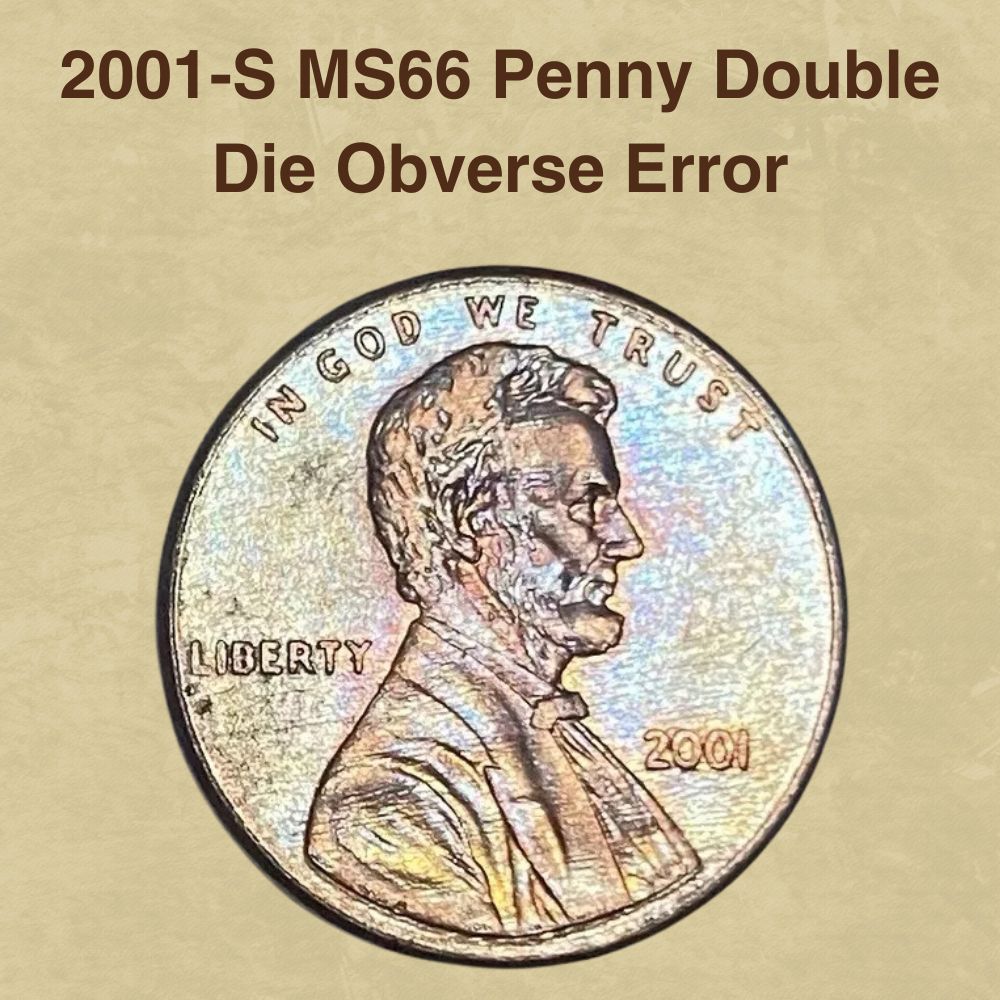
When collecting 2001 pennies you might also come across a doubled die error coin. This error occurs during the die creation process when the design is accidentally impressed two or more times onto the die at slightly different angles. This results in doubling on the devices and inscriptions on the coin.
Doubled die errors are generally more valuable because they result from a mistake in the die itself, unlike other types of doubling that occur during the coin minting process.
In 2021, a collector paid $950 at a Stack’s Bowers auction for a 2001-S penny graded MS6 with a double die error. On this coin the doubling is most noticeable on “LIBERTY” and “IN GOD WE TRUST,” where letters appear slightly overlapped.
5. 2001-P MS67 Penny Die Clash Error
You might also come across a die clash error when collecting 2001 pennies. This error occurs when the obverse and reverse dies come into contact without a planchet between them. This collision transfers parts of each die’s design onto the opposing die, creating ghost-like impression of one die’s design on the other.
A die clash error usually results from misaligned minting presses and can fetch good money depending on the intensity of the clash marks. In 2009, a collector paid $720 at a GreatCollections auction for a 2001-P penny graded MS67 with a die clash error. The coin showed faint outlines of the Lincoln Memorial on Lincoln’s profile, making it an interesting addition to your penny collection.
6. 2001-D MS66 Penny Broad-strike Error
One of the most dramatic errors you might encounter when building your 2001 pennies collection is a broad-strike. Also known as a broad-struck, this error occurs when a planchet is struck without being fully confined by the retaining collar.
When partially struck outside the collar, the planchet may expand outward, creating a flattened, outstretched appearance with a distorted rim.
In 2016, a 2001-P penny graded MS66 with a broad-strike error was sold for $685 at a Heritage auction. The coin spotted a rimless design and stretched details, giving it an unmistakable eye appeal.
7. 2001-P MS68 Penny Capped Die Error
Next on our list of 2001 penny errors is the capped die, one of the most dramatic you will come across. This error occurs when a struck planchet attaches itself to the die, essentially forming a “cap” over it.
The attached planchet or cap then becomes the new die, such that subsequent strikes produce coins with distorted or incomplete designs. It is common for coins with capped die errors to have a concave appearance on the obverse and an almost featureless reverse.
Capped die errors are rare; they disrupt the coin production process, prompting mint workers to correct the mistake immediately. The dramatic nature of this error combined with its rarity makes it a standout piece.
In 2010, a collector paid a remarkable $1,430 at a Heritage auction for a 2001-P penny graded MS68 with a capped die error.
8. 2001-P MS69 Penny Die Break Error
An error that often comes up in the 2001 penny series is the die break, which can appear on the obverse or reverse of the coin. This error occurs when part of the die chips away, leaving a small hole that gradually fills with tiny metal pieces, resulting in a raised bump on the die’s surface.
As the die continues striking, it eventually leaves an impression of the raised bump on one or more planchets, resulting in a die break error. Die breaks appear like raised bumps on the coin’s surface and are often an indication that the die was nearing the end of its service life.
Generally, larger, more peculiar die breaks are more valuable than smaller, subtle die break errors. In 2023, a collector at an eBay auction paid a whopping $1,200 for a 2001-P penny graded MS69 with a reverse die break error, a testament to this error’s rarity and desirability.
9. 2001-D MS67 Penny BIE Error
Another error on our list of the most valuable 2001 pennies is the BIE error. Essentially, this is a small die crack that forms between the “B” and “E” in “LIBERTY,” creating the appearance of an extra letter. This error occurs when a small piece of the die breaks away, leaving a vertical gap.
While this might seem like a minor error, a distinct BIE error coin can be worth a premium. In 2008, a collector paid $710 at a Stack’s Bowers auction for a 2001-D penny graded MS67 with a BIE error.
Summary
Our 2001 penny errors list reveals a variety of fascinating, high-value minting errors. From dramatic off-center strikes to captivating die cracks, these errors turn ordinary pennies into extraordinary collectibles. Whether you’re a seasoned collector or a curious hobbyist, collecting 2001 penny error coins offers a unique opportunity to add high-value errors to your collection. Happy collecting!
